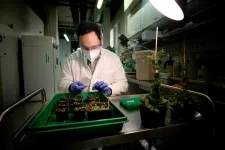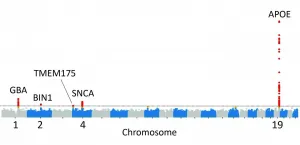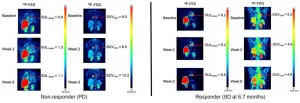(Press-News.org) Scientists from the National Renewable Energy Laboratory (NREL) have developed a simple way to better evaluate the potential of novel materials to store or release heat on demand in your home, office, or other building in a way that more efficiently manages the building's energy use.
Their work, featured in Nature Energy, proposes a new design method that could make the process of heating and cooling buildings more manageable, less expensive, more efficient, and better prepared to flexibly manage power from renewable energy sources that do not always deliver energy when it is most needed.
The paper, "Rate Capability and Ragone Plots for Phase Change Thermal Energy Storage," was authored by NREL's Jason Woods, along with co-authors Allison Mahvi, Anurag Goyal, Eric Kozubal, Wale Odukomaiya, and Roderick Jackson. The paper describes a new way of optimizing thermal storage devices that mirrors an idea used for batteries, helping to inform what new thermal storage materials are needed for buildings and how the devices should be designed with these materials.
Thermal energy storage allows buildings to function like a huge battery by storing thermal energy in novel materials until it can be used later. One example is a heat pump. While electricity is needed initially to create and store the heat, the heat is used later without using additional electricity.
In another example, some materials have the ability to change phases, like ice that can transition from a solid to a liquid. As the ice melts, it absorbs energy from and cools a working fluid, which can then be used to cool a building space. Because phase change occurs at a nearly constant temperature, useful energy can be provided or stored for a longer period at a steady temperature. Thermal energy storage is typically very "round trip" energy efficient.
The authors discovered that a Ragone plot, often used to characterize batteries, also works well to describe the potential effectiveness of various thermal storage device candidates. A Ragone plot shows the tradeoff between how much energy a device can store and its discharge power, or how quickly the device can release energy. This foundational approach makes comparisons between different thermal storage materials or device improvements easier to evaluate. It serves as a starting point for defining targets and is a useful design tool to develop new thermal storage materials and devices that can serve as novel, alternative energy storage options.
"This Ragone framework ensures cost-effective design of thermal storage materials and devices depending on the power and energy requirements of a particular application," said Jason Woods, a senior research engineer at NREL and lead author of the newly published paper.
Mahvi, a postdoctoral researcher at NREL, said another advantage is enabling technologies that can mitigate blackouts on the grid. "Most of peak electricity demand--especially in the summer when you might see blackouts--is driven by air conditioning. If you can move that demand to some other time of the day, you can help alleviate the strain on the grid, keeping the grid operational, but also keeping people indoors comfortable."
"Thermal energy storage systems will need to become more flexible and adaptable with the addition of onsite power generation, electric vehicle charging, and the combination of thermal storage with batteries," Woods said. "Part of this flexibility requires higher power--but this higher power comes at a cost of available energy, as this publication highlights."
The way in which the thermal energy storage is used will impact its performance. Scientists need to consider questions about how stored energy can best be used to keep building occupants comfortable, or for different applications like maintaining electronic equipment at a safe temperature.
"Which one works best for me and my application will depend on what the requirements are. How much do I need to store, and how fast do I need to discharge it?" Mahvi said. "This framework will allow us to optimize thermal storage systems from the material to the component scale to increase the power density while still accessing as much of the available capacity as possible. This will result in more efficient devices that can be used for a wide range of applications."
The researchers developed a computer model to understand the various design tradeoffs with these thermal storage devices, including ones that require high power (release the energy quickly) and low power (release the energy slowly). They also built a prototype phase change thermal storage device, illustrating this power-energy tradeoff in practice.
The Building Technologies Office in the U.S. Department of Energy's Office of Energy Efficiency and Renewable Energy funded this research.
NREL is the U.S. Department of Energy's primary national laboratory for renewable energy and energy efficiency research and development. NREL is operated for the Energy Department by the Alliance for Sustainable Energy, LLC.
INFORMATION:
Last year, researchers at Karolinska Institutet in Sweden and the Max Planck Institute for Evolutionary Anthropology in Leipzig, Germany showed that a major genetic risk factor for severe COVID-19 is inherited from Neandertals. Now the same researchers show, in a study published in PNAS, that Neandertals also contributed a protective variant. Half of all people outside Africa carry a Neandertal gene variant that reduces the risk of needing intensive care for COVID-19 by 20 percent.
Some people become seriously ill when infected with SARS-CoV-2 while others get only mild or no symptoms. In addition to ...
How do plants build resilience? An international research team led by the University of Göttingen studied the molecular mechanisms of the plant immune system. They were able to show a connection between a relatively unknown gene and resistance to pathogens. The results of the study were published in the journal The Plant Cell.
Scientists from "PRoTECT" - Plant Responses To Eliminate Critical Threats - investigated the molecular mechanisms of the immune system of a small flowering plant known as thale cress (Arabidopsis thaliana). PRoTECT ...
The ongoing health disaster of the past 12 months has exposed the crises facing nursing homes in Canada and the United States and the struggles of the staff working in them.
Writing in the Journal of Comparative Policy Analysis: Research and Practice, PhD student Daniel Dickson, his supervisor Patrik Marier, professor of political science, and co-author Robert Henry Cox of the University of South Carolina perform a comparative analysis of those workers' experiences. In it, they look at Quebec (including those at government-run CHSLDs), British Columbia, Washington State and Ohio ...
Hamilton, ON (February 16, 2021) - A McMaster stem cell research team has made an important early step in developing a new class of therapeutics for patients with a deadly blood cancer.
The team has discovered that for acute myeloid leukemia (AML) patients, there is a dopamine receptor pathway that becomes abnormally activated in the cancer stem cells. This inspired the clinical investigation of a dopamine receptor-inhibiting drug thioridazine as a new therapy for patients, and their focus on adult AML has revealed encouraging results.
AML is a particularly deadly cancer that starts with a DNA mutation in the blood stem cells of the bone marrow that produce too many infection-fighting white blood cells. According ...
The ongoing fight of science against cancer has made great strides, but cancer cells have not made it easy. The complexity of cancer cells and their adaptive evolutionary nature complicate the search for effective cures. Multiple DNA repair pathways in healthy cells typically work to rectify DNA damages caused by sources within the organism, like spontaneous DNA mutations, or from outside, like ultraviolet radiation.
But what happens when these pathways malfunction? It is known that deficiencies in these pathways increase the instability of the genes, and this causes cancer to develop. Therefore, detailed knowledge of how DNA repair pathways participate in this process is crucial for tracking tumor progression, understanding the emergence of drug ...
Melanoma is by far the deadliest form of skin cancer, killing more than 7,000 people in the United States in 2019 alone. Early detection of the disease dramatically reduces the risk of death and the costs of treatment, but widespread melanoma screening is not currently feasible. There are about 12,000 practicing dermatologists in the US, and they would each need to see 27,416 patients per year to screen the entire population for suspicious pigmented lesions (SPLs) that can indicate cancer.
Computer-aided diagnosis (CAD) systems have been developed in recent years to try to solve this problem by analyzing images of ...
In a study led by National Institutes of Health (NIH) researchers, scientists found that five genes may play a critical role in determining whether a person will suffer from Lewy body dementia, a devastating disorder that riddles the brain with clumps of abnormal protein deposits called Lewy bodies. Lewy bodies are also a hallmark of Parkinson's disease. The results, published in Nature Genetics, not only supported the disease's ties to Parkinson's disease but also suggested that people who have Lewy body dementia may share similar genetic profiles to those who have Alzheimer's disease.
"Lewy body dementia is a devastating brain disorder for which we have no effective treatments. Patients often appear to suffer the worst of both Alzheimer's ...
Reston, VA--Molecular imaging can successfully predict response to a novel treatment for ER-positive, HER2-negative metastatic breast cancer patients who are resistant to hormonal therapy. According to research published in the February issue of the Journal of Nuclear Medicine, positron emission tomography (PET) imaging using an imaging agent called 18F-fluoroestradiol can help to determine which patients could benefit from treatments that could spare them from unnecessary chemotherapy.
Nearly two-thirds of invasive breast cancers are ER-positive, and endocrine therapy is the mainstay of treatment for these tumors because of its favorable toxicity profile and efficacy. Should cancer progress in these patients, however, salvage endocrine therapy with molecularly targeted agents ...
Of the nine treatments and preventives for COVID-19 authorized for emergency use by the Food and Drug Administration, three are drugs made from so-called monoclonal antibodies. Such drugs provide patients with ready-made antibodies that neutralize the virus, bypassing the body's slower and sometimes less effective process of making its own antibodies.
But such therapies were developed without detailed information about how antibodies interact with the rest of the immune system during COVID-19. Faced with a new, deadly and fast-spreading disease, drug designers started work ...
Irvine, Calif., Feb. 16, 2021 -- A radioactive bone cement that's injected into bone to provide support and local irradiation is proving to be a safer alternative to conventional radiation therapy for bone tumors, according to a study led by University of California, Irvine researchers.
The study shows that this brachytherapy cement can be placed into spinal bones to directly irradiate tumors without harming the spinal cord, and the radioactive material will stay localized in the bones, which promises to virtually eliminate side effects.
Lead researcher Joyce Keyak, UCI professor of radiological sciences, presented the results at the 2021 annual meeting of the Orthopaedic Research Society, which was held virtually Feb. 12-16.
Cancers ...





